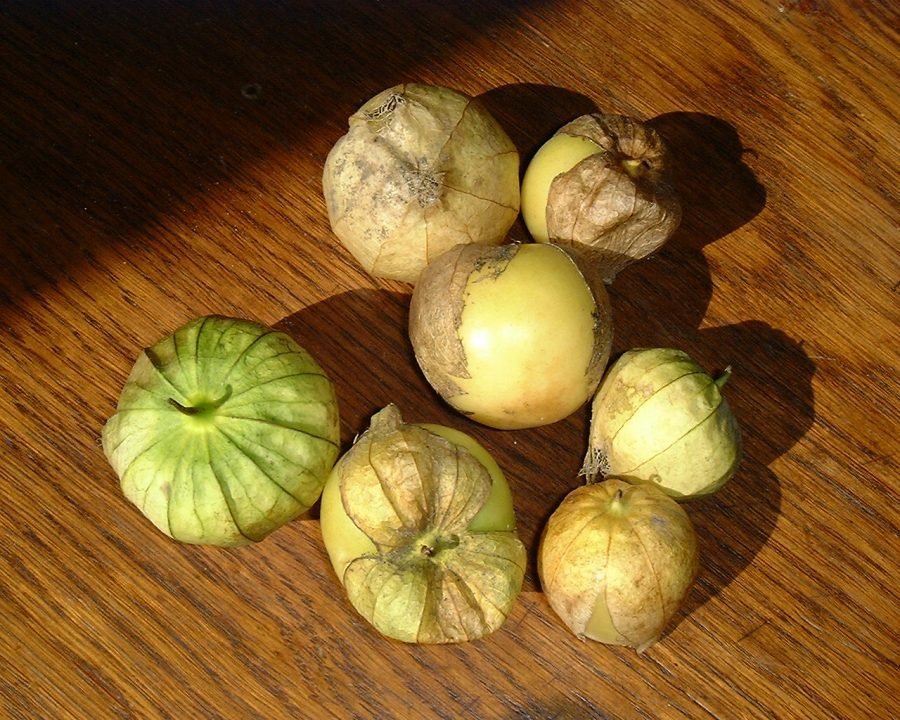Story and photos by Russ Grayson
FAST, TASTY, ABUNDANT — the fast fruits are suitable for even small community gardens.
Fast fruits are suitable for the community garden because they:
- are fast growing (that’s why they are called fast fruits)
- have a compact growth form — they don’t take much space and are suitable for smaller community and home gardens
- brings plant and food diversity to the garden
- have a place in garden landscape design
- are generally short lived — typically between four and seven years depending on plant; if your community garden is not guaranteed long-term tenure, you can still obtain a fruit harvest by growing the fast fruits rather than the slower growing varieties such as citrus, avocados and stone fruits.
For community gardeners, the fast fruits offer:
- a tasty source of vitamins and minerals necessary to our health
- a quick crop of tasty fruit — fast fruits may set fruit within three years, depending on species
- high productivity — in the best growing conditions they produce a heavy crop
- a way to make use of the space around slower growing fruit trees; as the slower fruit trees grow, the fast fruits can be thinned to make space for them.
Where to plant your fruit or nut trees and shrubs
Before you plant your fruit trees:
- think carefully about where the plants will cast shadows when they reach their mature size; avoid shading your vegetable growing area
- think about where the winter sun, which is lower in the sky that in summer, will cast longer shadows
- make sure that your fruit trees are not in the path of cold, blustery winter winds that could limit growth, cause windburn to the foliage and break branches.
Plant your fruit and nut trees separately from your annual garden beds so that:
- their roots do not compete with the vegetables for soil nutrients
- they do not shade out the vegetables or the allotments of neighbouring gardeners
- the annual beds can be periodically cleared to plant a different type of crop or to establish a seedbed for crop rotation.
In community gardens where the work and the harvest is shared, perennial and long-term vegetables might be interplanted among the fruit trees in a combined orchard/perennial area. Suitable varieties, depending on your climate and microclimate, might include globe and Jerusalum artichoke, yacon (Peruvian ground apple), yams, taro, sweet potato, New Zealand spinach, French sorrel, culinary and pest management herbs and leguminous species that build soil fertility.
Design for community gardens managed as allotments
In allotment gardens, individual gardeners have their own garden bed in which they grow food and other plants for themselves.
In this type of community garden:
- separate fruit into an orchard area even if fruit trees and shrubs belong to individual allotment holders; this prevents the trees and shrubs overshadowing other allotments
- fruit trees and tall shrubs should be kept out of allotments where vegetables and herbs are grown, however low-growing shrubs like cape gooseberry, blueberry and other berry fruits, including pepino, can be grown in vegetable allotments.
Make productive use of space
You can use the space around your slower-growing fruit and nut trees (such as citrus, avocado, apples and stone fruits) by planting the fast fruits between them.
When used this way, the fast fruits are known as a ‘catch crop’:
- it is a way to make use of space that will eventually be occupied by the slower-growing fruits
- the fast fruits utilise nutrients and resources such as water and sunlight until the slower-growing fruits and nuts grow to take over the space.
Catch cropping is managed by:
- planting fast fruits and the slower-growing fruits and nuts at the same time
- avoiding the crowding of your slower-growing fruit trees and shrubs by planting the fast fruits far enough from them
- eventually, removing some of the fast fruits as the slower-growing fruit and nut trees and shrubs mature and need more space.
Catch crops may include:
- the fast fruits
- long-lived vegetables such as globe artichoke, jerusalum artichoke, yacon (peruvian ground apple) and sweet potato
- annual scramblers such as pumpkin and melons
- nitrogen fixing annual or perennial ground covers and shrubs.
Nitrogen-fixers are the legumes that provide nutrients to our fruit trees and improve soil fertility. They are selected for climate and might include:
- shrubs such as pigeon pea and croatalaria
- ground covers such as clover, lablab bean, lupins and alfalfa (lucerne)
- in temperate climates, broad beans.
Other garden design considerations
in the southern hemisphere, locate the fruit trees to the south of your vegetable beds to avoid shading them
protect fast fruits from strong and cold winds; in Australia, if your garden is exposed to potentially damaging winter winds, consider planting a windbreak of trees and shrubs (if you have the space) such as:
- casuarina (common names: she oak or river oak)
- acacia (common name: wattle)
- grevillia
- small leaf lillypilly (syzygium leuhmanii – this is an Australian bush food; you can eat the fruit).
Copy the structure of the forest in your orchard area by planting:
- ground cover plants
- a shrub layer/small tree layer (the fast fruits do nicely for this)
- a canopy layer of taller fruit and nut trees — this vertical layering of plants according to shade tolerance and height is known as ‘stacking’.
Managing your fast fruits
To keep your fast fruits healthy:
- protect them from strong, cold winds
- provide plenty of water but do not over-water
- monitor them for plant diseases and insect pests
- maintain soil fertility by adding compost and mulch; keep mulch a couple centimetres away from the trunk of young fruit trees — if it is in contact with the trunk it can can result in collar rot, killing the tree.
Notes on the plant description
- growth form: sizes given are for mature plants, so allow sufficient space between trees and shrubs when planting your fruits; sizes are approximate only — the size a plant will grow to depends on microclimate, watering, soil fertility, the incidence of insects pests and plant diseases, exposure to cold, strong winds
- pollination: plants need to pollinate to set fruit; some plants require the presence of both female and male plants; some are self-pollinating and others might be bisexual hybrids producing fruit from a single plant while their non-hybrid form requires both male and female plants; including flowering annual and perennial plants in your garden attracts pollinating insects such as bees
- botanic name: these are the names botanists and horticulturists use to identify plants; sometimes, a single plant will have more than one common name, leading to confusion in identifying it; there is only one botanic name, so it is a more accurate way to identify a plant.
- spp: abbreviation for ‘species’ which denotes a particular plant variety
- centre of diversity: the region where the plant originated and from where it spread.
The species
BABACO
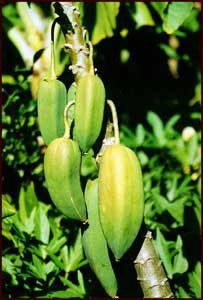
Botanic name : Carica pentagona
Growth form: similar to pawpaw — a single-stemmed plant with large, palmate leaves at crown; fruit produced from upper stem
Edible part: fruit; turns yellow when ripe, eaten raw or processed into sauces, chutneys or relishes
Growing & harvesting: babaco is a hybrid of the pawpaw.
Propagation: babaco is a sterile and is propagated from softwood cuttings.
Growing: needs frost free climate
Pests & diseases:
- similar to pawpaw
- insect pests include fruit fly if left to ripen on plant; mites on foliage
- diseases include viruses; root rot
Centre of diversity: Ecuador. Discovered by botanists in 1922.
BANANA
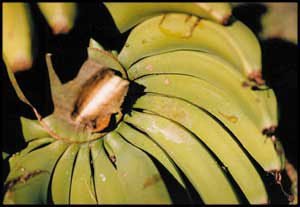
Botanic name: Musa spp
Growth form:
- single stemmed plant with large, broad leaves at crown reaching three metres (cavendish) to five metres (sugar banana, lady fingers) in height
- fruit produced in bunches on stem from main stem; large purple flower at end of fruiting stem.
Edible part:
- fruit — turns yellow when ripe unless a cooking banana which remains green
- eaten raw (unless a cooking banana variety)
- some species, less common in Australia but common in the Pacific islands and Asia, are cooked.
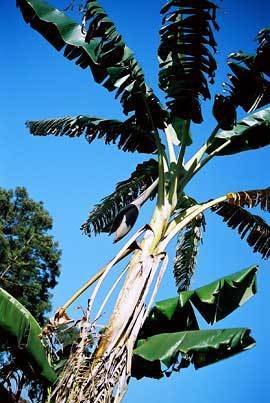

Growing & harvesting:
- propagation — bananas grow by suckering from the root mass; allow a single stem to grow beside the mature stem to replace it after fruiting
- self-pollinating
- when the fruit has grown to preferred size, cut off the purple male flower (sometimes known as the ‘bell’)
- fruit on the tree may need bagging in some areas to protect it from fruit bats
- when the fruit on tree starts to ripen, the bunch can be cut off and hung in a warm, protected place until fully ripe
- needs a frost-free climate.
Centre of diversity: South East Asia.
BERRIES
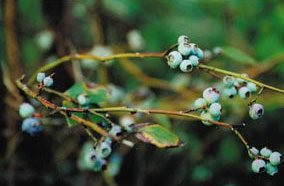
A range of berry fruits are suitable for the community garden.
Selection:
Species are selected depending on climate:
- raspberry (Rubus idaeus) — warm to cool temperate climate, cold winters
- blackberry (Rubus subgenus eubatus) — cool temperate climate, cold winters (in parts of Australia the blackberries is considered an invasive weed; check with the state department of agriculture or your local council)
- gooseberry (Ribes glossularia) — cool temperate climate
- blackcurrant (Ribes nigrum) — cool temperate climate
- redcurrant ( Ribes sativum) — cool temperate climate
- blueberry (Vaccinium corymbosum) – varieties suitable for cool temperate and warmer climates
- strawberry (Fragaria spp) — cool temperate to warm temperate.
In Australia, species adapted to a cool temperate climate are suited for growing in Tasmania, southern Victoria and the Southern Highlands of NSW.
Strawberry and blueberry varieties are available for warmer climates such as Sydney and coastal northern NSW. Blueberry are fruit fly resistant, making them suitable for planting in the Sydney region and places north. Berry fruits are not suited to arid regions.
Growth form: shrub or trailing
Edible part: berry; eaten raw or made into jam
Growing & harvesting: depends on species.
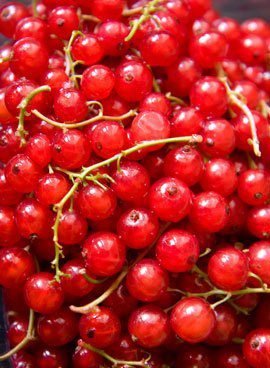
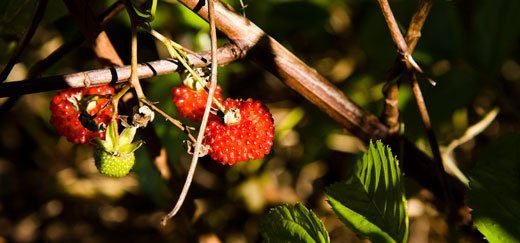
CAPE GOOSEBERRY
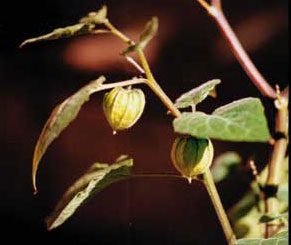
Botanic name: Physalis peruviana
Growth form: perennial shrub to one metre high and wide.
Edible part:
- sweet, round, yellow fruit to two centimetres diameter inside papery husk
- eat raw, as a dessert or make into jam.
Growing + harvesting:
- self-pollinating
- propagated by seed
Centre of diversity: Peru.
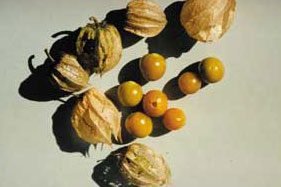
MIDYIM BERRY

Botanic name: Austromyrtus dulcis
Growth form
- shrub to one metre high and wide
- short, waxy, pointed leaves.
Edible part: soft, sweet, round, whitish, purple flecked fruit to one centimetre diameter eaten raw.
Growing + harvesting:
An Australian bush food eaten by Aboriginies
- tolerates sandy soils
- tolerates full sun
- grows in large container
- self-pollinating.
Centre of diversity: Australia.
PASSIONFRUIT
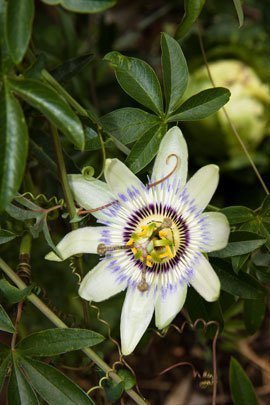
Botanic name: Passioflora edulis
Growth form:
- climber
- grow along fence or on trellis.
Edible part:
- fleshy inside of fruit
- eat raw or make into jam or sauce.
Growing + harvesting: grows in large container up to three years to first fruiting.
Several varieties are available including:
- the purple-skinned variety
- the larger yellow-skinned ‘Hawaiian’ variety
- the long banana passionfruit suited to cool temperate climates.
Propagation: from seed; self-pollinating.
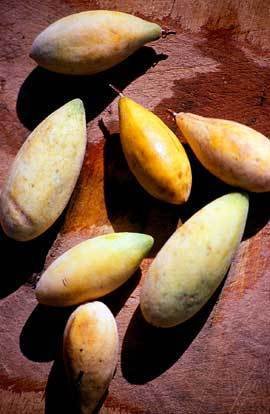
PAWPAW
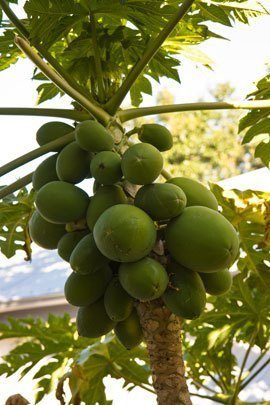
Botanic name: Carica papaya
Growth form:
- single stemmed plant with large, palmate leaves growing from crown
- grows to four metres in height
- fruit grows from upper trunk.
Edible part: fruit, turns yellow when ripe. Unripe fruit cooked as a vegetable or grated as salad vegetable.
Growing + harvesting:
- pollination — needs male plants (ratio about one male to seven female)
- nurseries sell hybrid bisexual which fruits on single plant; these save space in small community and home gardens
- propagated from seed — except for hybrid variety
- needs frost free climate.
Pests + diseases:
Insect pests: fruit fly if fruit left to ripen on plant; mites on foliage
Diseases: viruses; root rot
Centre of diversity: South America
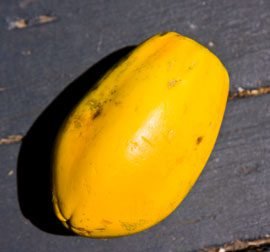
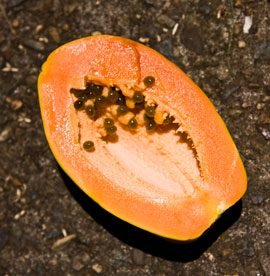

PEPINO
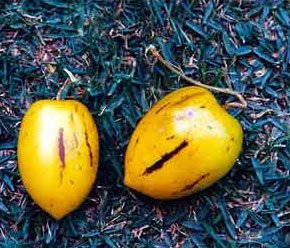
Botanic name: Solanum muricatum
Member of the tomato family (Solanum).
Growth form:
- shrub to one metre high and wide
- long, pointed (lanceolate) leaves.
Edible part: round or egg-shaped fruit to 10 centimetres in length with thin skin that turns yellow or creamy colour with purple streaking when rip; eaten raw.
Growing + harvesting:
- several varieties available
- grows as container plant
- fruits within a year in best conditions
- grows in large container
- moderate frost tolerance
- tolerates moderate shade – use as an understorey
- avoid hot, dry conditions
- propagation from cuttings
- insect pests – aphids, slugs, mites, white fly
Centre of diversity: Peruvian highlands of South America
TAMARILLO
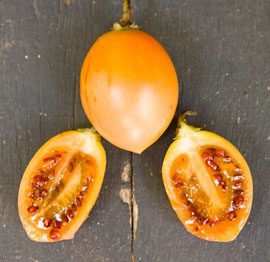
Also known as tree tomato.
Botanic name: Cyphomandra betacea
Growth form: small, branching tree to three metres high and two metres wide, broad, soft leaves.
Edible part: oval-shaped, sweet tasting, red or yellow fruit, eaten raw or made into jam.
Growing + harvesting:
- propagation
- from seed
- self-pollinating
Growing:
- frost free climate
- moderately shade tolerant – can use as understorey planting; will also grow in full sun
- usually fruits within two years
Centre of diversity: South America.
TOMATILLO
Also known as jamberberry.
Botanic name: Physalis ixocarpa
Growth form:
- perennial shrub to one metre high and wide
- round fruit to two centimeres diameter may need soaking to separate from fruit
Edible part: fruit; eaten raw.
Growing + harvesting:
- plant in a warm microclimate
- grows as a container plant
- propagation from seed.
Centre of diversity: South America.
